The global alkali-resistant penetrant market, expanding from USD 1,225 million to USD 2,299.5 million between 2025 and 2035, will be shaped heavily by raw material sourcing patterns and dependence on imports. Growth of 87.7% and a CAGR of 6.5% highlight strong demand, but regional cost structures will vary due to sourcing imbalances.
Asia Pacific will dominate volume consumption, with China leveraging its silane and siloxane production capacity to supply domestic markets and neighboring economies. This reduces import reliance and positions Chinese suppliers as key global exporters. In contrast, India and Southeast Asia remain highly dependent on imports, leaving manufacturers exposed to foreign exchange fluctuations and shipping costs. Europe shows a mixed profile, where specialty chemical clusters in Germany and France provide stable internal supply, but imports of fluoropolymer intermediates from Asia add vulnerability. North America benefits from a strong petrochemical base, though select specialty compounds are still imported to balance capacity shortfalls. Latin America, the Middle East, and Africa stand as the most exposed, almost fully dependent on imports, with higher landed costs limiting wider adoption.
The cost impact of imported inputs will continue to influence procurement cycles. Price surges in silane and fluorinated compounds, often linked to upstream oil volatility or regional production constraints, have the potential to compress margins across construction and infrastructure projects. Transportation bottlenecks and regulatory shifts in Asia or Europe could further exacerbate supply risks.
Strategic responses are beginning to shape competitive positioning. Manufacturers with backward integration or long-term sourcing agreements are better able to control input costs. Regional players without such integration rely on distributors, leaving them vulnerable to delays and price shocks. Efforts to diversify sourcing channels and increase local production capacity are gaining momentum, particularly in Asia and the Middle East. Innovation in alternative chemistries with reduced reliance on high-cost imported intermediates is also emerging as a key differentiator. The trajectory of market growth through 2035 will therefore not only depend on demand from construction and industrial projects but also on the ability of producers to manage raw material supply chains. Competitive advantages will accrue to regions and companies that secure reliable sourcing, optimize cost management, and reduce dependency on imported inputs.
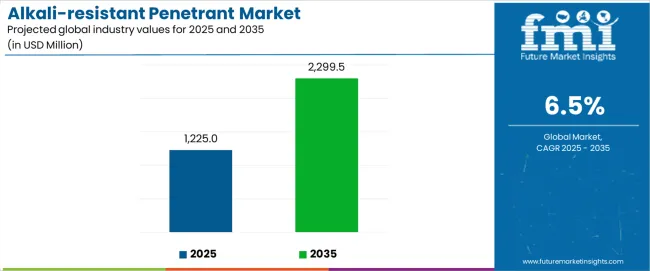
| Item | Value / Description |
|---|---|
| Market Value (2025) | USD 1,225 million |
| Forecast Value (2035) | USD 2,299.5 million |
| Forecast CAGR (2025 to 2035) | 6.5% |
| Leading Product Type (2025) | Anionic - 52% share |
| Leading Application (2025) | Building Materials Industry - 58% share |
| Leading Distribution Channel (2025) | Direct Sales - 68% share |
| Key Growth Regions | China; India; Germany |
| Top Companies by Market Share | SUNG DA; DONGKE GROUP; Zhejiang sindeal |
| Metric | Value |
|---|---|
| Market Value (2025) | USD 1,225 million |
| Market Forecast Value (2035) | USD 2,299.5 million |
| Forecast CAGR (2025 to 2035) | 6.5% |
| INFRASTRUCTURE DevELOPMENT TRENDS | INDUSTRIAL PROCESSING REQUIREMENTS | TECHNOLOGY & PErfORMANCE STANDARDS |
|---|---|---|
| Construction Industry Expansion - Continuous growth of infrastructure projects across established and emerging markets driving demand for high-performance alkali-resistant penetrant solutions. | Industrial Equipment Protection - Modern industrial facilities require advanced penetrants delivering enhanced alkaline resistance and long-term surface protection. | Chemical Resistance Standards - Industry requirements establishing performance benchmarks favoring high-precision alkali-resistant penetrant formulations. |
| Building Materials Innovation - Growing emphasis on durable construction materials and chemical resistance creating demand for specialized penetrant systems. | Manufacturing Process Optimization - Industrial facilities investing in premium penetrants offering superior alkaline protection while maintaining operational efficiency. | Surface Treatment Optimization - Quality standards requiring optimal penetration depth and minimal substrate degradation in industrial applications. |
| Infrastructure Modernization - Superior chemical resistance and surface protection capabilities making alkali-resistant penetrants essential for high-performance construction applications. | Durability Requirements - Certified penetrants with proven specifications required for long-term industrial surface protection applications. | Formulation Technology Requirements - Advanced chemical compositions and molecular structures driving need for precision manufacturing capabilities. |
| Category | Segments / Values |
|---|---|
| By Product Type | Anionic; Cationic; Nonionic; Others |
| By Application | Building Materials Industry; Textile Industry; Industrial; Others |
| By End-Use Industry | Construction; Manufacturing; Chemical Processing; Infrastructure; Others |
| By Formulation | Water-based; Solvent-based; Emulsion; Others |
| By Distribution Channel | Direct Sales; Chemical Distributors; Specialty Retailers; Online Channels; Regional Dealers |
| By Region | North America; Europe; Asia Pacific; Latin America; Middle East & Africa |
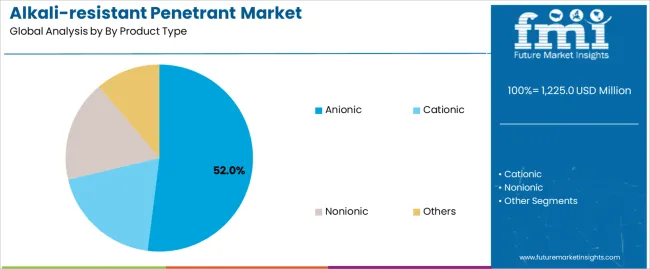
| Segment | 2025 to 2035 Outlook |
|---|---|
| Anionic | Leader in 2025 with 52.0% market share; likely to maintain strong position through 2035. Superior alkaline resistance properties, broad compatibility with construction materials, and cost-effective manufacturing. Momentum: steady growth. Watchouts: competition from nonionic formulations in specialized applications. |
| Cationic | Premium segment with 28.5% share, benefiting from enhanced bonding characteristics and specialized industrial applications requiring superior surface adhesion. Momentum: rising in high-performance markets. Watchouts: higher costs and compatibility limitations. |
| Nonionic | Versatile option for diverse industrial applications and multi-surface treatments, gaining share due to environmental compatibility. Momentum: growing due to regulatory preferences. |
| Others | Includes specialty formulations and hybrid penetrants for specialized industrial applications. High performance characteristics, niche applications. Momentum: selective growth in specialized industrial and infrastructure segments. |
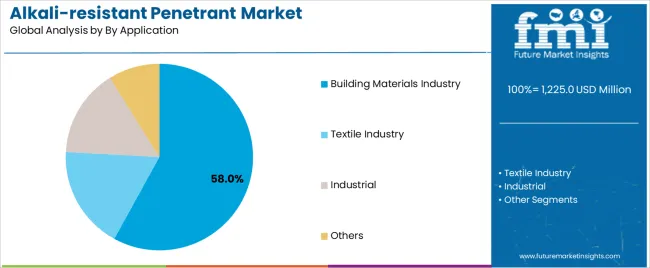
| Segment | 2025 to 2035 Outlook |
|---|---|
| Building Materials Industry | Largest application segment in 2025 at 58.0% share, supported by construction industry growth and infrastructure development. Driven by concrete protection, masonry treatment, and structural enhancement requirements. Momentum: strong growth from infrastructure investments and building material innovations. Watchouts: competition from alternative protection systems and economic construction cycles. |
| Textile Industry | Key segment for fabric treatment and fiber protection applications. Requires specialized penetrants for alkaline processing environments and dyeing operations. Momentum: steady growth through textile industry expansion. Watchouts: sustainability requirements and alternative treatment methods. |
| Industrial | Professional manufacturing facilities rely on alkali-resistant penetrants for equipment protection and surface treatment in chemical processing environments. Momentum: moderate growth in specialty manufacturing. Watchouts: automation and alternative protection technologies. |
| Others | Specialized segments including automotive, aerospace, and marine applications requiring specific alkaline resistance properties and performance characteristics. Momentum: selective growth driven by specialized industrial requirements. Watchouts: limited market size and stringent certification requirements. |
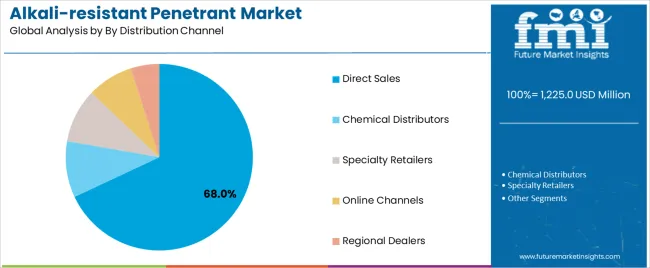
| Distribution Channel | Status & Outlook (2025 to 2035) |
|---|---|
| Direct Sales | Dominant channel in 2025 with 68% share for industrial-grade penetrants. Offers technical consultation, customized formulations, and professional application support. Momentum: steady growth driven by industrial customer requirements and technical service demands. Watchouts: margin pressure and competition from distributors. |
| Chemical Distributors | Rapidly growing channel serving regional customers seeking specialized formulations and technical expertise. Provides value through inventory management and local support. Momentum: strong growth as market expands geographically; regional expertise accelerating adoption. |
| Specialty Retailers | Traditional channel for construction and industrial maintenance applications. Broad market reach with limited technical specialization. Momentum: stable for standard products, declining for premium applications. Focus shifting toward demonstration capabilities. |
| Online Channels | Expanding channel for commodity-grade penetrants and small-volume customers. Includes manufacturer websites and B2B platforms. Momentum: rising as customers seek convenience and competitive pricing with enhanced technical documentation. |
| Regional Dealers | Specialized channel catering to local construction and industrial customers. Expert knowledge of regional specifications and application requirements. Momentum: moderate growth fueled by local infrastructure development and customer relationships. |
| DRIVERS | RESTRaiNTS | KEY TRENDS |
|---|---|---|
| Expanding infrastructure development across established and emerging markets is driving demand for high-performance alkali-resistant penetrants. | Alternative protection systems and competing surface treatment technologies continue to limit penetrant adoption in certain applications. | Development of advanced formulation chemistry, molecular engineering techniques, and performance optimization are enabling superior alkaline resistance. |
| Industrial Processing Growth - Increasing chemical processing and manufacturing activities requiring alkaline-resistant surface protection is creating demand for specialized penetrants. | Environmental Regulations - Stringent environmental standards and VOC limitations restrict certain formulation options and increase compliance costs. | Smart Coating Integration - Enhanced formulation designs, improved penetration mechanisms, and optimized chemical resistance are advancing performance capabilities. |
| Construction Quality Standards - Rising demand for durable construction materials in commercial and infrastructure applications fuels steady penetrant adoption. | Economic Sensitivity - Construction and industrial market fluctuations affect penetrant demand and investment in protective surface treatments. | Specialized Application Development - Emerging demand for penetrants tailored to specific industrial processes, environmental conditions, and substrate requirements. |
| Limited Product Alternatives - Specialized alkaline resistance requirements create sustained demand for high-performance penetrant solutions. | Technical Complexity - Application requirements and performance optimization affect adoption rates and maintenance procedures. | Ongoing R&D Innovation - Continuous improvement in chemical formulations, application methods, and performance characteristics to meet evolving industrial standards. |
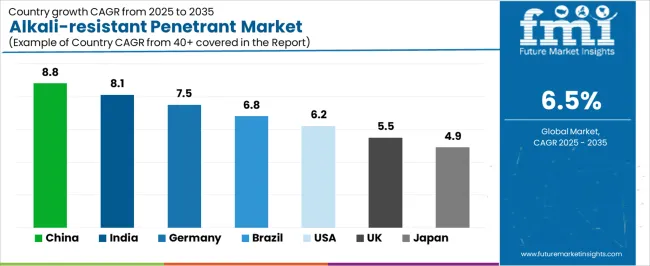
| Country | CAGR (2025–2035) |
|---|---|
| China | 8.8% |
| India | 8.1% |
| Germany | 7.5% |
| Brazil | 6.8% |
| USA | 6.2% |
| UK | 5.5% |
| Japan | 4.9% |
Revenue from alkali-resistant penetrants in China is projected to exhibit strong growth with a market value of USD 421.6 million by 2035, driven by expanding construction infrastructure and comprehensive industrial development creating substantial opportunities for chemical suppliers across construction operations, manufacturing facilities, and specialty industrial sectors. The country's established chemical manufacturing tradition and expanding construction capabilities are creating significant demand for both anionic and cationic penetrant systems.
Major chemical companies and construction material manufacturers including SUNG DA and DONGKE GROUP are establishing comprehensive local production facilities to support large-scale construction operations and meet growing demand for efficient alkali-resistant solutions.
Revenue from alkali-resistant penetrants in India is expanding to reach USD 342.8 million by 2035, supported by extensive infrastructure expansion and comprehensive industrial development creating demand for reliable penetrant solutions across diverse construction categories and manufacturing segments.
The country's growing industrial base and expanding construction sector are driving demand for chemical solutions that provide consistent alkaline resistance while supporting cost-effective system requirements. Chemical distributors and construction suppliers are investing in local market development to support growing industrial operations and infrastructure demand.
Demand for alkali-resistant penetrants in Germany is projected to reach USD 287.3 million by 2035, supported by the country's leadership in precision chemical manufacturing and advanced penetrant technologies requiring sophisticated formulation systems for industrial and construction applications.
German chemical companies are implementing high-precision manufacturing systems that support advanced alkaline resistance capabilities, operational reliability, and comprehensive quality protocols. The alkali-resistant penetrant market is characterized by focus on engineering excellence, chemical precision, and compliance with stringent environmental and performance standards.
Revenue from alkali-resistant penetrants in Brazil is growing to reach USD 241.9 million by 2035, driven by infrastructure development programs and increasing construction industry growth creating opportunities for chemical suppliers serving both construction operations and industrial manufacturing contractors.
The country's extensive infrastructure requirements and expanding industrial awareness are creating demand for penetrant chemicals that support diverse construction requirements while maintaining performance standards. Chemical retailers and specialty equipment service providers are developing distribution strategies to support operational efficiency and customer satisfaction.
Demand for alkali-resistant penetrants in United States is projected to reach USD 203.7 million by 2035, expanding at a CAGR of 6.2%, driven by advanced industrial processing excellence and specialized chemical capabilities supporting comprehensive manufacturing development and industrial facility applications.
The country's established chemical manufacturing tradition and mature industrial market segments are creating demand for high-quality penetrant chemicals that support operational performance and environmental standards. Chemical manufacturers and industrial suppliers are maintaining comprehensive development capabilities to support diverse industrial requirements.
Revenue from alkali-resistant penetrants in United Kingdom is growing to reach USD 171.5 million by 2035, supported by industrial heritage and established chemical manufacturing communities driving demand for premium penetrant solutions across traditional industrial systems and specialized processing applications.
The country's established industrial heritage and advanced chemical manufacturing capabilities create demand for penetrant chemicals that support both legacy system maintenance and modern high-performance applications.
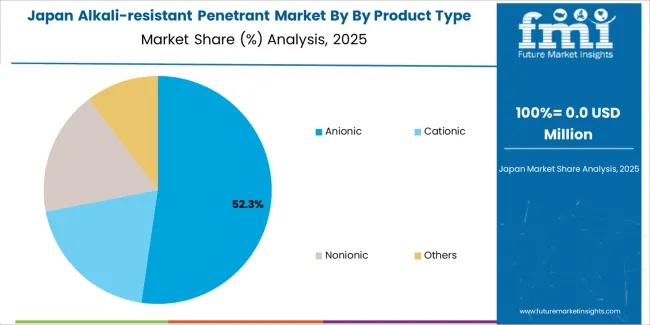
Demand for alkali-resistant penetrants in Japan is projected to reach USD 144.2 million by 2035, driven by precision chemical manufacturing tradition and established penetrant technology leadership supporting both domestic industrial markets and export-oriented chemical production. Japanese companies maintain sophisticated penetrant development capabilities, with established manufacturers continuing to lead in specialized formulation technology and precision manufacturing standards.
European alkali-resistant penetrant operations are increasingly concentrated between German precision chemical engineering and broader regional industrial manufacturing. German facilities dominate premium penetrant production for specialized industrial and construction applications, leveraging advanced formulation technologies and strict environmental protocols that command price premiums in global markets. Regional manufacturers maintain leadership in traditional penetrant designs and construction-grade formulations, with companies driving technical specifications that smaller suppliers must meet to access industrial contracts.
Eastern European operations in Poland and Czech Republic are capturing volume-oriented production contracts through skilled labor advantages and EU regulatory compliance, particularly in standard anionic penetrants for construction applications. These facilities increasingly serve as manufacturing capacity for Western European brands while developing their own formulation expertise.
The regulatory environment presents both opportunities and constraints. REACH compliance requirements create quality standards that favor established European manufacturers over imports while ensuring consistent performance specifications. Brexit has created complexity for UK chemical sourcing from EU suppliers, driving opportunities for direct relationships between manufacturers and international distributors.
Supply chain consolidation accelerates as manufacturers seek economies of scale to absorb rising raw material costs and precision manufacturing expenses. Vertical integration increases, with major construction chemical manufacturers acquiring penetrant production facilities to secure chemical supplies and quality control. Smaller manufacturers face pressure to specialize in niche applications or risk displacement by larger, more efficient operations serving mainstream construction and industrial requirements.
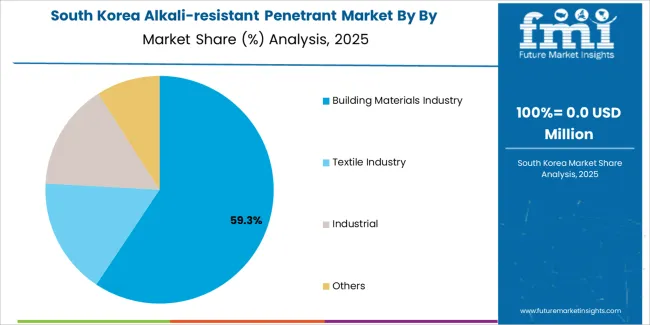
South Korean alkali-resistant penetrant operations reflect the country's advanced chemical manufacturing sector and export-oriented business model. Major industrial conglomerates including LG Chem and SK Innovation drive chemical procurement strategies for their construction material divisions, establishing direct relationships with specialized penetrant suppliers to secure consistent quality and pricing for their construction and industrial operations targeting both domestic and international markets.
The Korean market demonstrates particular strength in integrating penetrant technologies into advanced construction materials, with companies developing products that bridge traditional surface treatment and modern high-performance building systems. This integration approach creates demand for specific performance specifications that differ from conventional applications, requiring suppliers to adapt formulation capabilities and alkaline resistance characteristics.
Regulatory frameworks emphasize chemical safety and environmental compatibility, with Korean Chemical Registration and Evaluation Act standards often exceeding international requirements. This creates barriers for smaller chemical suppliers but benefits established manufacturers who can demonstrate compliance capabilities. The regulatory environment particularly favors suppliers with K-REACH certification and comprehensive documentation systems.
Supply chain efficiency remains critical given Korea's technological advancement focus and competitive market dynamics. Companies increasingly pursue development contracts with suppliers in Germany, Japan, and specialized manufacturers to ensure access to advanced penetrant technologies while managing technological risks. Investment in research and development supports quality advancement during extended product development cycles.
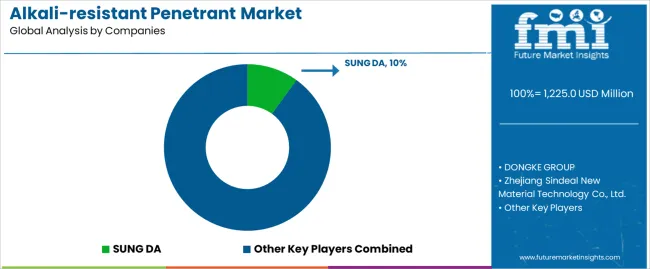
Profit pools are consolidating upstream in precision chemical formulation and downstream in application-specific penetrant designs for construction, industrial, and specialized processing markets where certification, alkaline resistance performance, and consistent chemical properties command premiums.
Value is migrating from basic penetrant production to specification-driven, application-ready formulations where chemical expertise, formulation technology, and reliable performance characteristics create competitive advantages.
Several archetypes define market leadership: established Chinese manufacturers defending share through manufacturing excellence and cost efficiency; international chemical companies leveraging advanced formulation expertise and global distribution; specialty chemical producers with proprietary formulation intellectual property and industrial application connections; and emerging manufacturers pursuing cost-competitive production while developing technical capabilities.
Switching costs - application compatibility, industrial qualification, system integration - provide stability for established suppliers, while technological advancement and performance requirements create opportunities for innovative manufacturers. Consolidation continues as companies seek manufacturing scale; direct sales channels grow for premium products while traditional distribution remains relationship-driven.
Focus areas: secure construction and industrial market positions with application-specific performance specifications and technical support; develop formulation technology and precision manufacturing capabilities; explore specialized applications including infrastructure protection and chemical processing requirements.
| Stakeholder Type | Primary Advantage | Repeatable Plays |
|---|---|---|
| Chinese Manufacturing Leaders | Production scale; cost efficiency; established supply chains | Large-volume manufacturing; competitive pricing; regional market penetration |
| International Chemical Companies | Advanced formulations; global distribution; brand recognition | Technical innovation; international expansion; premium positioning |
| Specialty Chemical Producers | Application expertise; technical support; specialized formulations | Industrial relationships; custom solutions; technical service capabilities |
| Regional Manufacturers | Local market knowledge; distribution networks; customer relationships | Regional expansion; local partnerships; market-specific products |
| Chemical Distributors | Distribution networks; inventory management; customer service | Technical support; logistics optimization; market development |
| Item | Value |
|---|---|
| Quantitative Units | USD 1,225 million |
| Product Types | Anionic; Cationic; Nonionic; Others |
| Applications | Building Materials Industry; Textile Industry; Industrial; Others |
| End-Use Industries | Construction; Manufacturing; Chemical Processing; Infrastructure; Others |
| Formulations | Water-based; Solvent-based; Emulsion; Others |
| Distribution Channels | Direct Sales; Chemical Distributors; Specialty Retailers; Online Channels; Regional Dealers |
| Regions Covered | North America; Latin America; Europe; Asia Pacific; Middle East & Africa |
| Key Countries | China; India; Germany; Brazil; United States; United Kingdom; Japan (+35 additional countries) |
| Key Companies Profiled | SUNG DA; DONGKE GROUP; Zhejiang sindeal New Material Technology Co., Ltd.; Shanghai Jiujie Chemical Co., Ltd.; Yinhuchem; Linyi Guoli Chemical Co., Ltd.; JHUAWG; BASF SE; Dow Chemical Company; Huntsman Corporation; Clariant AG; Solvay SA; Wacker Chemie AG; Arkema Group; Evonik Industries |
| Additional Attributes | Dollar sales by product type and distribution channel; Regional demand trends (NA, EU, APAC); Competitive landscape; Direct vs. distributor adoption patterns; Manufacturing and formulation integration; Chemical engineering innovations driving alkaline resistance enhancement, performance reliability, and technical excellence |
The global alkali-resistant penetrant market is estimated to be valued at USD 1,225.0 million in 2025.
The market size for the alkali-resistant penetrant market is projected to reach USD 2,299.5 million by 2035.
The alkali-resistant penetrant market is expected to grow at a 6.5% CAGR between 2025 and 2035.
The key product types in alkali-resistant penetrant market are anionic, cationic, nonionic and others.
In terms of by application, building materials industry segment to command 58.0% share in the alkali-resistant penetrant market in 2025.






Full Research Suite comprises of:
Market outlook & trends analysis
Interviews & case studies
Strategic recommendations
Vendor profiles & capabilities analysis
5-year forecasts
8 regions and 60+ country-level data splits
Market segment data splits
12 months of continuous data updates
DELIVERED AS:
PDF EXCEL ONLINE

Thank you!
You will receive an email from our Business Development Manager. Please be sure to check your SPAM/JUNK folder too.
Chat With
MaRIA